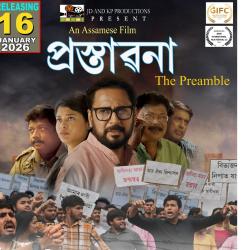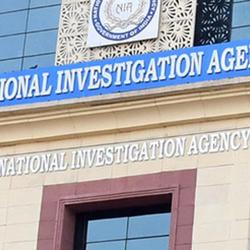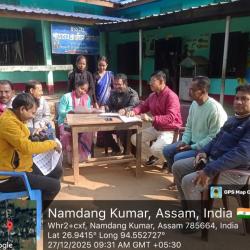1925. The Nagaon session of the Asam Sahitya Sabha. The then president of the premiere literary body of the state stressed the need for the spread of women’s education. Ironically, a bamboo-net barrier segregated the women from the men present in the conference. Chandraprabha went up to the dais and denounced the practice. She called upon the women to break down the barrier that confined them--- the fences were broken down and it stays so, never to come up again. This fiery lady is Chandraprabha Saikiani, the pioneer feminist in the modern history of Assam.
Chandraprabha Saikiani was born on March 16, 1901 in Doisingari village of Kamrup district in Assam. Her father Ratiram Mazumdar was the gaonburha (headman) of the village. He had elementary education and urged his daughters to go for studies in the local MV school. Chandraprabha not only educated herself, but was equally concerned about the education of the girls in her surroundings. She was just thirteen when she established a girls’ school in Akaya village. She brought some girls under her fold and beneath a school with a thatched roof opened new vistas before them. It was in this shed of a school that, Neelakanta Barua, the then school inspector spotted Chandraprabha, the teenage teacher of the village school. He could see the spark and desire for education in Chandraprabha. She was awarded a scholarship to study in the Nagaon Mission School. Her younger sister Rajaniprabha accompanied her. Rajaniprabha too was entitled to a scholarship and later went on to become the first lady doctor of Assam.
The thought of how a largely illiterate rural society at the dawn of the last century steeped in highly conventional notions of womanhood could produce a woman like Chandraprabha, a woman who was far ahead of her time in her thoughts and actions is amazing. Chandraprabha became a harbinger of change in her surroundings and immediate society. She protested against the actions of the school authority in not allowing a student to stay in the hostel when she refused to convert to Christianity. Chandraprabha’s protested against this procedure of the school. Her protests compelled the authorities to change their decision and the girl had to be inducted into the hostel. On completing her education, Chandraprabha was working in Nagaon for a while. Then she was appointed the headmistress of Tezpur Girls’ ME school. Her life in Tezpur broadened her horizons as she came into the contact of illustrious personalities like Omeo Kumar Das, Chandra Nath Sarma, Jyotiprasad Agarwala to name a few.
In 1918, during the session of Asom Chhatra Sanmilan, Chandraprabha addressed a large gathering against the evil effects of opium eating and demanded an immediate ban on it throughout the state. This was an epoch making event in the history of women’s emancipation in Assam as it was for the first time that a woman spoke in a massive public meeting. At that time, Chandraprabha was seventeen years of age.
Chandraprabha was deeply affected by the evils of the caste system. The teachings of the medieval Vaishnava saint of Assam, Srimanta Sankardev inspired her to fight against the malpractice. She stood for the equality of all sections of people in the society. Her untiring efforts lead to the opening of the doors of the Hajo Hayagriva Madhav temple to one and all, irrespective of caste and creed.
Inspired by Gandhiji’s ideals, Chandraprabha joined the non-cooperation movement in 1921 and beckoned to the womenfolk to do the same. Chandraprabha turned her attention to organizing the women in the villages. Under her leadership, the Asam Pradeshik Mahila Samity was born in the year 1926. The organisation spread out its wings throughout the state, taking up issues of child marriage, spread of women’s education, self employment for women, and stress on handloom and handicraft. The mahila samiti, which is also the first organized women’s movement in Assam, stands firm till date and has grown into an institution in itself, devoting itself to the ideals laid down by Chandraprabha Saikiani. She edited the Mahila Samiti`s journal Abhijatri for seven years. She gave vent to her feelings through the many poems written by her and work of fiction. Her novel Pitribhita was published in 1937.
Chandraprabha Saikiani’s life is a legend in itself. The rebel in her found expressions in her personal life too. During her days in Tezpur, young Chandraprabha came across prolific writer Dandinath Kalita. He expressed his love for her and she reciprocated his feelings. But their sublime emotions had to surrender at the divisive dictats of the society. Her paramour Dandinath was of no match to Chandraprabha’s fearless spirit. He dared not challenge the age-old caste system to take Chandraprabha as his wife or as the mother of his yet unborn child, and married a girl in tune with the wishes of his family. This is enough for any average young woman to break down. And we can only imagine her misery under such circumstances in early 20th century, when the society looked down upon unwed mothers. But Chandraprabha rose to this challenge. She never lost heart and played the role of a single mother to perfection. She not only brought up her only son Atul Saikia with all maternal care single-handedly, but also imbibed in him noble qualities of head and heart. The same boy later grew up to be a man who made significant contribution to the Trade Union movement in Assam. At the age in which she lived, doing the things she did was far from possible, infact unthinkable. But Chandraprabha Saikiani did them all, and with great dignity, conviction and integrity.
In 1972, in view of her outstanding contribution towards the upliftment of women and selfless work for the betterment of society, Chandraprabha Saikiani was conferred the Padmashree. But she died a couple of days before the day the honour was ceremonially conferred on her, adding another odd to a life full of struggles. Chandraprabha Saikiani breathed her last on March 16, 1972 ; which is also the day she was born. In 2002, this firebrand lady of Assam is also being honoured by the Government of India this year with the release of a commemorative postage stamp. The former Girls’ Polytechnic Institute in Guwahati has been named after Padmashree Chandraprabha Saikiani. The Government of Assam has instituted an annual award in her honour for personalities with extraordinary contribution towards betterment of women and the society. Whatever recognition has come her way is far too inadequate for an iron lady like Chandraprabha Saikiani who changed the lives of hundreds and thousands of rural women. Her life is a story of which legends are made of. She is the pioneer of the feminist movement in Assam. Chandraprabha Saikiani’s name would go down the annals of history as one of role models of women emancipation in 20th century India.
Today, on her birth and death anniversary, we pay homage to this lesser known lady who stirred the lives of millions in the north-eastern corridors of our country.
- Add new comment
- 58387 reads










Comments
Pages
Add new comment